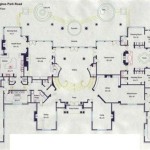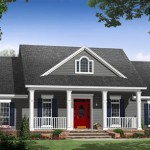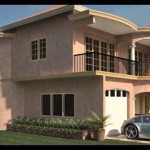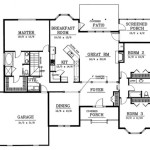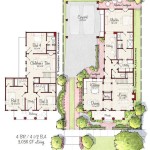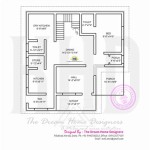Maine Farmhouse House Plans: Blending Tradition with Modern Living
Maine farmhouse house plans represent a unique architectural style deeply rooted in the state's history and landscape. These plans capture the essence of rural New England living while incorporating contemporary amenities and design principles. The result is a home that offers both comfort and a connection to the past, making them a popular choice for those seeking a blend of traditional charm and modern convenience.
The traditional Maine farmhouse evolved organically over time, reflecting the needs and resources of farming families. The designs prioritized functionality and durability, utilizing locally sourced materials like wood and stone. Modern Maine farmhouse house plans retain these core values while adapting to contemporary lifestyles and building codes. This evolution has led to a diverse range of floor plans and design elements that cater to varied preferences and lot sizes.
A key aspect of Maine farmhouse house plans is their emphasis on natural light and connection to the outdoors. Large windows, porches, and decks are common features, allowing residents to appreciate the surrounding scenery. The incorporation of sustainable building practices is also increasingly prevalent, reflecting a commitment to environmental responsibility and energy efficiency. These homes are designed not only to be aesthetically pleasing but also to minimize their impact on the environment.
Key Point 1: Defining Characteristics of Maine Farmhouse Architecture
Several defining characteristics distinguish Maine farmhouse architecture from other styles. These features often include a simple, rectangular footprint, gabled roofs, and clapboard siding. The emphasis on practicality and functionality is evident in the layout and design. While aesthetics are important, the primary focus is on creating a comfortable and efficient living space.
The use of natural materials is another hallmark of Maine farmhouse architecture. Wood is a predominant element, utilized for framing, flooring, and interior finishes. Stone foundations and chimneys are also common, reflecting the availability of this resource in the region. These materials not only contribute to the aesthetic appeal of the homes but also provide durability and insulation.
Porches play a significant role in Maine farmhouse design. Often wrapping around the front or side of the house, porches offer a sheltered space for relaxation and socializing. They serve as a transitional zone between the interior and exterior, allowing residents to enjoy the outdoors while remaining protected from the elements. The design of the porch often reflects the overall style of the house, with details such as decorative railings and turned posts.
Chimneys are frequently a prominent feature of traditional and modern Maine farmhouse designs. Historically, they were essential for providing heat and ventilation. Today, they often serve as a focal point, adding character and visual interest to the exterior. Chimneys may be constructed of brick or stone, and their design can range from simple to elaborate, depending on the overall style of the house.
Modern iterations of the Maine farmhouse style often incorporate elements of contemporary design, such as open floor plans and updated fixtures. However, the fundamental principles of simplicity, functionality, and connection to nature remain central to the design. This blending of traditional and modern elements allows for a seamless integration of old-world charm and contemporary convenience.
Key Point 2: Modern Adaptations and Floor Plan Considerations
While retaining the essence of traditional design, modern Maine farmhouse house plans incorporate several adaptations to meet the needs of today's homeowners. These adaptations range from changes in floor plans to the integration of modern amenities and technologies. Understanding these adaptations is crucial for selecting a plan that aligns with individual preferences and lifestyle.
One of the most significant changes in modern Maine farmhouse design is the prevalence of open floor plans. Traditional farmhouses often featured compartmentalized rooms, reflecting a focus on functionality and separation of spaces. Modern plans, however, prioritize open and airy living areas that promote social interaction and natural light. This open concept typically combines the kitchen, dining area, and living room into a single, unified space.
The inclusion of modern amenities is another key aspect of modern Maine farmhouse adaptations. These amenities may include updated kitchens with stainless steel appliances, spa-like bathrooms with soaking tubs and walk-in showers, and energy-efficient heating and cooling systems. While the aesthetic of the home may remain traditional, the functionality and comfort are significantly enhanced by the incorporation of these modern conveniences.
Flexibility in floor plan design is also a defining characteristic of modern Maine farmhouse house plans. Many plans offer options for customizing the layout to accommodate specific needs and preferences. This may include adding bedrooms, home offices, or recreational spaces. The ability to personalize the floor plan allows homeowners to create a space that truly reflects their individual lifestyle.
Energy efficiency is a major consideration in modern Maine farmhouse design. Features such as high-performance windows, insulation, and HVAC systems are often incorporated to minimize energy consumption and reduce utility costs. The orientation of the house is also carefully considered to maximize solar gain in the winter and minimize heat gain in the summer. These energy-efficient features contribute to the sustainability and long-term affordability of the home.
Key Point 3: Materials and Finishes for a Maine Farmhouse Aesthetic
The selection of materials and finishes plays a crucial role in achieving an authentic Maine farmhouse aesthetic. The use of natural, locally sourced materials is highly encouraged, as it reinforces the connection to the surrounding landscape and contributes to the overall character of the home. Careful attention to detail in the selection of materials and finishes can elevate the design and create a space that feels both timeless and inviting.
Wood is a dominant material in Maine farmhouse design, used extensively for framing, siding, flooring, and interior finishes. Choices range from reclaimed barn wood to sustainably harvested lumber. The type of wood used and its finish can significantly impact the overall aesthetic. Natural wood tones and textures are often preferred, as they evoke a sense of warmth and authenticity.
Exterior siding is another important consideration. Clapboard siding is a classic choice, offering a traditional look that is both durable and weather-resistant. Other options include shiplap siding, board-and-batten siding, and vertical siding. The color of the siding also plays a crucial role in defining the aesthetic of the home. Traditional colors such as white, gray, and muted greens are common choices.
Interior finishes should complement the overall design aesthetic. Hardwood floors are a popular choice, providing warmth and durability. Other flooring options include tile, stone, and laminate. Walls are often painted in neutral colors to create a light and airy atmosphere. Shiplap paneling, wainscoting, and exposed beams can add character and visual interest to the interior.
Hardware and fixtures should also be carefully selected to complement the Maine farmhouse aesthetic. Antique brass or wrought iron hardware can add a touch of traditional charm. Farmhouse-style sinks, pendant lighting, and vintage-inspired appliances can further enhance the authenticity of the design. The key is to choose materials and finishes that are both functional and aesthetically pleasing, creating a cohesive and harmonious living space.
The incorporation of natural elements, such as stone fireplaces and exposed brick walls, can also contribute to the character of a Maine farmhouse. These features add texture and visual interest to the interior, creating a sense of warmth and connection to the surrounding landscape. The use of natural light is also crucial, with large windows and skylights strategically placed to maximize sunlight exposure. The goal is to create a space that is both comfortable and inviting, reflecting the beauty and simplicity of rural New England living. Ultimately, selecting the right Maine Farmhouse house plan will be dependent on personal preference, lot size and orientation, budget and other factors that can be determined with more consultation with a construction or architect professional.

The Maine Farm House Floor Plan

Maine Idea House

Farmhouse Style House Plan 3 Beds 2 Baths 1398 Sq Ft 430 200 Houseplans Com

Farmhouse Style House Plan 2 Beds Baths 1400 Sq Ft 17 2024 Houseplans Com

Maine Cottage Home Bunch Interior Design Ideas

Farmhouse Style House Plan 4 Beds 2 5 Baths 1880 Sq Ft 1074 59 Houseplans Com

House Plans Floor Blueprints

Committing To Memory Maine Home Design House Exterior Barn Style

A Twenty First Century Saltwater Farmhouse Maine Home Design Coastal Plans Modern Beach House Exterior

10 Small House Plans With Open Floor Blog Homeplans Com


